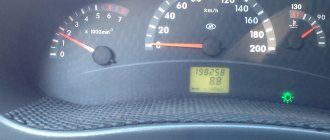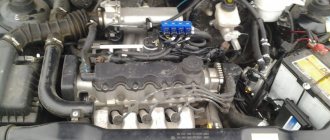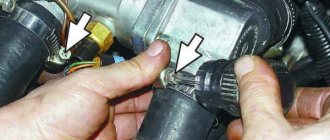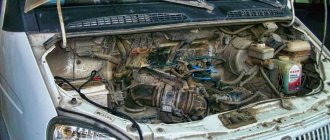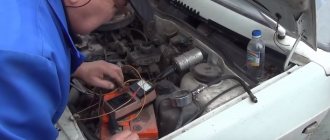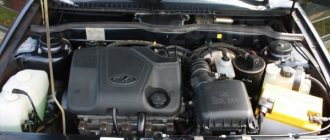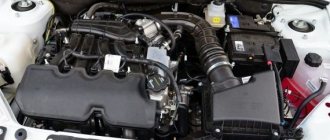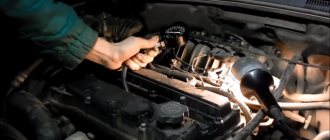Spark plug
Very often the engine on a VAZ 2114 stalls due to faulty spark plugs. Sometimes a check mark blinks on the dashboard. Visual inspection often allows you to identify failed elements. In this case, you may notice carbon deposits, as well as other dirt and damage. You can check the serviceability of the spark plug with the help of a friend, since it is difficult to do this alone. The check is carried out as follows: One person starts the car starter, and the other puts the metal part of the spark plug with a high voltage to the engine. If the element is working properly, a spark should appear when the starter operates. If it is not there, the spark plugs need to be changed.
What to do if the engine starts to stall
8-valve injection engine VAZ 2114
In order to determine why the engine in a VAZ 2114 is misfiring, you must follow the recommendations of professionals. First of all, you need to determine which cylinder is out of order, for this you need to:
- open the hood with the engine running;
- remember the sound and nature of the operation of the power plant;
- remove the high-voltage wires from the spark plugs one by one, if the sound and rhythm of operation changes, then continue further, as soon as it is discovered that when the spark plug is de-energized, the nature of the sound does not change, which means the faulty cylinder has been identified.
Next, you need to unscrew the spark plug and determine its condition and performance.
It is unscrewed using a special spark plug wrench, which is recommended to be carried with you in an emergency kit. It takes up little space, but is a unique key that cannot be replaced and can come in handy at the most unexpected time. After all, even simply by replacing a heavily carbonated spark plug with a new one, you can temporarily solve the problem with starting the engine.
The next step is to determine the condition of the removed spark plug. If the electrode is intact and clean, and there is a large amount of soot on the head, then with a high degree of probability it can be determined that dust has entered the combustion chamber of the cylinder, therefore the fault must be looked for in the air supply system through the air filter.
If the entire head, along with the electrode, is covered in smoke, and it is severely burnt out, it means that a lean mixture was supplied and detonation combustion occurred with ignition advance. When the head is also completely covered with smoke and the electrode is in good condition, this means that a rich mixture was supplied and there was a delay in the ignition supply.
Assessing the condition of the spark plug gives direction in finding the true cause of cylinder failure. However, you should also check the performance of the candle itself. There is a proven method for this - “by spark”. If a spark breaks through, even if weak due to carbon deposits, then you must definitely look further. But if there is no spark at all, then you should replace the spark plug with a new one and check it. If there is a good spark, you can try to start the car and monitor the dynamics of changes.
Spark plug faults
If the car has a fairly high mileage, then trying to find the reason why the engine is shaking, you must do the following:
- change the spark plug;
- change the set of high-voltage wires; during prolonged operation under conditions of high temperatures and voltages, microcracks appear on the shell, leading to breakdowns and failure; experienced auto electricians recommend periodically changing this set for prevention;
- measure the compression in the idle cylinder; if it is broken, then perhaps the rings are stuck or the valves are burnt out;
- adjust the valves, this procedure should be carried out for prevention every 15 - 20 thousand kilometers;
- determine the performance of the ignition coil, this is a fairly common failure, the best solution is to replace the old one with a new one;
- change the air filter;
- Check that the timing belt is installed correctly.
All the specified procedures have been completed, but the engine still “troubles”. We need to move on:
- Conduct diagnostics of the electronic control unit and replace if necessary.
- Check the fuel supply system, down to the injectors.
- Determine the performance of the oxygen sensor, if it is faulty or produces deteriorated indicators - repair or replace.
- The failure of the crankshaft position sensor is determined by the computer, and an error should be generated indicating a breakdown. If this happens, replace it.
Mass air flow sensor
The answer to the question of why the VAZ 2114 engine fails is sometimes a faulty mass air flow sensor. This reason should be suspected if checking the ignition and fuel injection system did not give any result. It is often indicated by characteristic errors on the on-board computer or detected by a diagnostic scanner. You can view the decoding of the codes in the car's operating instructions or on the Internet. When the mass air flow sensor breaks down, the car often not only jerks, but also does not gain momentum. There is a decrease in power and increased fuel consumption. Testing the part with a multimeter or checking by installing a known-good part will help determine problems. Sometimes external defects can be noticed on the sensor during inspection. The element cannot be repaired. Therefore, if it malfunctions, it should be replaced.
Injector and ignition coil
Let's start with the spark plugs. For injection engines, special spark plugs are produced, the parameters of which must correspond specifically to your car. The second ignition element is a module that replaced the distributor. These were the most common reasons why the check for a VAZ 2114-2115 might light up.
Mass air flow sensor is a very important element of any injection engine.
Most often, the “check” can blink and the engine may run unstably when the fourth cylinder of the injector, which has 8 valves, fails. If you continue to use a faulty car, you may very soon need an expensive overhaul of the power unit or its complete replacement.
It often happens that the appearance of the “CHECK” icon is associated with a malfunction in the “brains” of the car. To perform the action you will need a special K-line cable, a tablet (laptop), software and a little knowledge of automotive electricals.
The problem is in the operation of the coolant temperature sensor (coolant temperature sensor) - the on-board computer records a reduced signal level. Check the connection circuit and sensor. There is no CO controller pulse. Open circuit or sensor failure. An incorrect pulse is supplied from the mass air flow sensor controller. The idle speed sensor does not work or does not work correctly. The appearance of these errors indicates a problem with a break or short circuit in the IAC (idle speed regulator) wiring.
The solution is to check and replace them if necessary. The spark plug gap should be 1.3 millimeters. If there is no spark from the ignition coil and, if necessary, replace it, there should be no scatter in the values - 1-4 and 2-3 - measure the resistance at the coil terminals. Gas pump or strainer in the gas tank. In some cases, cleaning the mesh or directly replacing the fuel pump helps. Next, connect the megger clamp to the first tip, secure the second clamp to the pan.
As a result, it turned out that the valve seat sank. So, check the valve clearances when cold. 40 rubles. I changed the block on the crankshaft sensor.
The check engine light flashes when there is a risk of damage to the catalyst. And this is usually engine tripping. When the engine is running, the fuel in one of the cylinders does not burn and is thrown out into the exhaust pipe. Due to the fact that the temperature in the pipe is very high, gasoline burns out already there, or enters the catalyst in an unburned form.
The sensitive element of the catalyst can very quickly fail with all the ensuing consequences. That's why the check light flashes to attract the driver's attention! It is IMPOSSIBLE to move forward in this mode!
ECU
The reasons for unstable engine operation should sometimes be sought in the computer if diagnostics of other parts and systems did not help. The engine control unit breaks down infrequently. But, if this happens, the device will need to be replaced or reflashed. It is not recommended to do these operations yourself. Therefore, if you suspect a unit failure, you should contact a service station within a reasonable time for diagnosis and repair. A new part is not cheap, but a replacement will prevent more serious damage to the power unit and restore its normal operation. A characteristic sign of a unit malfunction is tripping not only when the engine is cold, but also when the engine is warm.
Vehicle malfunction at idle
If the VAZ 2114 power unit idles at idle, then:
In the first case, the fuel system is flushed and the injectors are cleaned. To carry out the last work, ultrasound is used. In the second case, you will need to replace the spark plugs, high-voltage wires, and diagnose the ignition coils. In the latter case, the valves are replaced or readjusted.
If the power unit stalls while running hot, then auto mechanics advise carrying out similar work as described above. At idle speed with a heated engine, one cylinder may not work due to malfunctions in the fuel mixture supply system or lack of spark. In this case, it is recommended to carry out the same work as in case of failures during cold running.
Before you begin independent repair work, you need to find out what tripling of the power unit is. This concept means the operation of the engine without the participation of one of the cylinders. If such a process is accompanied by a blinking check, then the lambda probe, fuel tank filler cap, catalyst, air mass flow sensor are checked. The motor indicator icon appears without warning, so it is impossible to immediately find out the reason for the blinking check. Before repairing a VAZ, the electrical circuit and design features of the vehicle are studied.
If you lack experience and knowledge in the field of electromechanics, it is recommended to seek help from a specialized service.
Consistently unstable operation of the vehicle's power plant, with evenly repeating interruptions, when approaching the exhaust pipe, audibly perceived as the operation of a “tractor” means that the engine is “troubling.”
Malfunctions of the connecting rod and piston group
Defects in the connecting rod and piston group are usually observed on engines with very high mileage or due to improper operation and maintenance of the machine. When these parts fail, the engine often stalls when cold. Low compression and unpleasant sounds when the engine is running, especially when not warmed up, can indicate a problem. A final determination of the problem is possible by disassembling and inspecting the power plant. It is recommended that repairs and diagnostics be done by an experienced mechanic. Sometimes the engine may stall due to a faulty crankshaft position sensor and other, more rare reasons. If you cannot identify and eliminate them yourself, it is advisable to contact specialists as soon as possible. Driving with unstable engine operation is not prohibited. But sometimes it leads to serious engine damage. Therefore, if, in addition to tripping, there are other symptoms of a malfunction of the power unit, and they increase, it is better to stop using the car until repairs are made.
Reasons for unstable operation of the VAZ 2114 engine cylinder block
The most common diagnosis you can hear is that the cylinder has failed. In fact, this formulation is not entirely correct. The cylinder has stopped working, that's it. But there can be many reasons for this incident:
- the spark plug is faulty or partially damaged;
- low compression in cylinders;
- the valves have not been adjusted for a long time or they do not fit well;
- the injectors are overfilled or clogged and require replacement;
- the high-voltage spark plug wire is broken;
- the oxygen sensor has failed;
- malfunction in the ignition coil;
- the electronic control unit has failed;
- The crankshaft position sensor (CPS) has failed;
- The timing belt has fallen off completely or has moved several notches;
- The air filter is not working well or is very dirty.
The consequences of stopping the operation of the cylinder can be detected both instantly, that is, directly during inspection of the machine, and in a delayed mode; it is these consequences that are most dangerous for the machine.
It is immediately apparent:
- increased vibration, which manifests itself due to a rhythm disturbance in the operation of the valves and, accordingly, all rotating parts of the engine and transmission;
- significantly increased fuel consumption due to disturbances in the injection system and the appearance of a characteristic smell of exhaust gases due to an increase in the concentration of harmful impurities and unburned fuel in them;
- a noticeable drop in the power of the power plant and, accordingly, the maneuverability of the vehicle.
If, immediately after detecting signs of engine “triple”, measures are not taken to identify and eliminate the causes of this phenomenon, this can lead to failure of the entire unit and its overhaul or replacement. The fact is that gasoline is constantly injected into the idle cylinder, which, without burning, mixes with the incoming oil and goes into the crankcase. If this condition lasts for a long time, the oil dilutes, loses its lubricating properties, and engine parts begin to work in extreme mode, wearing off and forming chips. The consequences will be felt very quickly and the engine will have to be sent to capital.
The engine stalls, the check light flashes or lights up: the main reasons
Let's start with the fact that injection engines are equipped with special catalyst devices for cleaning the exhaust. At the same time, the catalytic converter is a rather vulnerable and at the same time expensive element, and all sorts of malfunctions in the engine create a risk of damage.
As a rule, the check flashes when there is a risk of damage to the catalyst. In this case, the simultaneous tripping of the engine means that one or more cylinders are not working or are not working correctly. In practice, this means that the fuel in the problem cylinder does not burn completely, after which it enters the exhaust system.
As a result, the remaining unburnt fuel burns out in the area where the catalyst is located, since the temperatures there are very high. Fuel also gets on the catalyst itself, causing it to fail.
It becomes clear that the check often lights up when problems arise with the combustion of the mixture in the cylinders. It is not difficult to guess that such combustion can be disrupted for a number of reasons, ranging from problems with
ignition system
or fuel supply and ending with lack of intake air,
air leak
,
reduced compression
in the engine cylinder, etc.
It should be added that the check also often lights up in the event of failure of any ECM sensors. One way or another, it is quite obvious that the “check” in the vast majority of cases indicates either problems with the electronic engine control system itself, or the risk of damage to the catalyst due to malfunctions of the internal combustion engine.
It is important to understand that the engine tripping indicates a non-functioning cylinder. In this case, the check is flashing not due to the failure of any ECM sensor, malfunction of the exhaust gas recirculation system or poor fuel in the tank, but rather signals to the driver about a direct threat to the catalyst.
In a nutshell, fuel that is not burned and gets into the outlet causes a special sensor (lambda probe, oxygen sensor) to send readings to the ECU indicating deviations from the norm. The control unit begins to try to correct the situation, but taking into account the tripping, it is simply not able to adjust the operation of the motor so that everything returns to normal. As a result, fuel consumption increases, while the engine operates unstably, idle speed fluctuates, etc. In some cases, the motor “falls” into emergency mode.
This mode is necessary in order to minimize damage to the catalyst and the internal combustion engine itself. In practice, this is expressed in such a way that although the driver presses on the gas, the car in emergency mode with the “check” on still does not accelerate above 30-40 km/h, the crankshaft does not spin up, engine traction disappears, etc.
This feature of engine operation is primarily aimed at preventing burnout or melting of the catalyst. The catalyst itself consists of small honeycomb cells. If unburned fuel intensively enters the exhaust and burns out in the catalyst, the element will simply melt.
This melting will lead to the fact that exhaust gases will not be able to pass normally through the catalyst, that is, a plug appears in the exhaust pipe. Naturally, the engine will “suffocate”, power will drop, the engine may not start at all, etc.
Also, the catalyst will no longer be able to clean the exhaust, and toxicity will increase. There is only one way out in this situation - repairing the engine to eliminate the main cause of the engine tripping, and only then replacing the expensive catalyst with a new one. To minimize risks, a special program is programmed into the ECU, which involves operating the engine in emergency mode.
What's the result?
As you can see, if the engine stalls and the check engine light blinks, it is necessary to determine the cause as quickly as possible. A timely call for service or repairs will allow you to avoid subsequent troubles with the catalyst and lambda.
It must be remembered that tripping and misfires do not always indicate a serious breakdown. In some cases, it is enough to replace the spark plugs or explosive wires, while in others the engine still needs to be repaired.
In this case, the spark on the candles will be normal, the injectors will also supply fuel, the compression measurement will not reveal any deviations from the norm, but the “check” in this case will still blink or blink.
The main signs by which you can determine problems with the DPKV crankshaft position sensor. Causes of failures, breakdowns, self-check.
When you sharply press the gas pedal, the engine jerks, jerks and dips appear, the car does not pick up speed: the main causes of the malfunction and diagnostics.
For what reasons may misfire of the fuel-air mixture occur in one or more cylinders? Fault diagnosis, recommendations.
Why does the check light light up on the dashboard? Is it possible to continue driving a car if the check engine light is on? What should you check first?
Why the engine may not pick up speed: gasoline engine, diesel unit, car with LPG. Fault diagnosis, useful tips.
The engine does not start after washing the engine: the main reasons why the power unit cannot be started. What can be done in such a case.
- ordinary user
- Group: Users
- Posts: 863
I really want to understand the logic of the car owner. Why was the decision made to replace the spark plug wires and module? And how do misadjusted valves shake the engine one day and light the check light, but the next day the engine does not shake?
“"Maybe someone has encountered this, where should I dig?" - I have come across the reasons for describing this behavior (the engine sometimes shakes or does not shake and the check pin winks) this forum is unlikely to be able to handle.
How to decipher and eliminate errors on a VAZ 2114
Car self-diagnosis
Before we begin to decipher the error codes of the on-board computer on the VAZ 2114 and 2115, we will talk about self-diagnosis. It must be taken into account that checking the vehicle independently and using special equipment at a service station can give different results. The equipment available to professionals will allow you to more accurately detect problems than diagnosing problems using a dashboard. Combinations of breakdowns will also be different. Nevertheless, self-diagnosis of malfunctions of the eight-valve “four” is useful.
How to view and find out about breakdowns that the control unit has recorded independently:
- First you need to sit in the driver's seat and hold down the odometer button on the speedometer.
- Then insert the key into the ignition and set it to the first position.
- After turning the key, you must release the pressed button. This will cause the needles on the speedometer, tachometer and other gauges to move quickly.
- Then you need to press the odometer key again and release it. An inscription with the firmware version will appear on the device.
- After the third press of the odometer button, the VAZ 2114 error codes will start to light up on the display.
How to reset errors yourself
After self-diagnosis of errors and elimination of their causes on a carburetor or injection engine, a malfunction message may remain on the standard panel. If the problem has been deleted, this means that the code combination remains in memory. We'll look at the description of the faults below, and now we'll tell you how to remove the code from memory. To remove it after testing the device, when VAZ 2114 errors appear, the codes themselves must be written down. After this, the daily mileage reset button is pressed again, this will clear the fault from the control unit’s memory.
Resetting the "Check Engine" error
It often happens that the instrument panel 2114 8 or 16 valves displays a check error - engine malfunction, the orange icon is on. Self-diagnosis does not always allow you to accurately check and determine how to fix such a problem. To fix the problem and find a solution, you should perform more detailed diagnostics of the car using a computer and additional equipment. Perhaps, during diagnostics, an unknown error indicates a malfunction in the microprocessor, on-board network or sensors. After the problem is fixed, the receipt may remain.
The "Check Engine" indicator indicates a problem with the engine.
How to reset the fault code:
- First, turn on the ignition; you do not need to start the car engine.
- Then open the hood. Use a wrench to loosen the bolt on the negative terminal of the battery.
- Wait about one minute, after which the battery terminal must be replaced.
- Close the hood and turn off the ignition.
- After that, turn it on again and start the car engine. If the check remains, it should go out on its own after some time. If the instructions given did not work and the solution did not help, then you need to look for the cause of the problem and fix it.
The check light is on for VAZ 2114 reasons the engine is working normally
When this alarming sign flashes, drivers begin to look for reasons why the check on the VAZ 2114 came on. Owners of foreign cars were the first to notice such an icon; today it has become available for domestic cars. This is evidence that the machine is equipped with an electronic control system, the operation of which cannot be ensured without a certain number of sensors. They monitor the operation of all major engine systems and send data to the electronic control unit.
It is useful for all owners to know the reasons why the check light came on for a VAZ 2114, so that this signal does not cause alarming thoughts about why this happened. Many drivers only become aware of this when they notice it appearing on the dashboard. Experts say that there are many reasons for the appearance of signals, some of them can be eliminated by drivers, while others may require computer diagnostics.
Why is a warning system needed?
A panel that flashes periodically or is constantly on, which depicts an engine outline, or has the inscription “Check Engine” can be translated as “check the engine.” Its appearance warns the driver about emerging problems in the power unit. Most of all, its appearance worries novice drivers, but there is no need to be afraid, you just need to diagnose the engine and then eliminate the identified faults. The first such blocks were connected to an on-board computer; its main purpose was to control the carburetor of the power unit.
Cars are constantly improving, and so are electronic control units. Now they control other systems, such as ignition, supply, formation of a combustible mixture, engine speed, and other parameters. As a result of this modernization, the reasons for the control unit to react have become many times greater, so it has become much more difficult to understand the reasons for the appearance of warning signals, and sometimes it is completely impossible to do without special equipment.
The signal flashed, what should I do?
It is worth immediately warning that the appearance of such an alarm icon is not in all cases a signal of danger. When you try to start the engine, the check signal should flash and go out after a few seconds. This was a check of the functionality of all systems, and the extinguishment of the lamp confirms their serviceability.
If it lights up and does not go out for a long time, you need to treat it carefully. The control unit has detected problems and notifies the driver. They can be of varying complexity, both “petty” and requiring immediate intervention to eliminate them.
A few words about the reasons
In some cases, the check icon flashing while driving may be due to insufficient oil level in the engine crankcase. What can be recommended in this case? Stop driving, stop and listen to the engine. While listening for the presence of extraneous sounds, at the same time inspect the attachments and the presence of traces of oil leaks on the cylinder block. Check the oil level a few minutes after stopping the engine; if there is a shortage, you need to add the required amount of lubricant.
Also, the cause of the alarm signal may be problems in the ignition system, namely in one or more spark plugs (see the article “Signs of faulty spark plugs”). The appearance of a warning icon may be caused by poor quality fuel, which is quite common at gas stations.
A little more about Check Engine
If the cause of the signal is “bad fuel,” then replacing it eliminates this problem. Incorrect gap between spark plug electrodes, defects in insulator skirts, and problems with the ignition coil can also cause it to appear.
Inspect the spark plug insulators and check the gap in the electrodes, it should not be more than 1.3 mm. The coil can be checked for the presence of a spark or the resistance of its windings can be measured with a multimeter.
Problems with the oxygen sensor, also called a lambda probe, are also displayed in the Check Engine. It is necessary to check this sensor and, if its malfunction is confirmed, replace it with a new device. The same can be said about catalysts, for which the use of leaded gasoline will be harmful.
Problems that arise in the fuel system are solved by flushing the injectors. It is also necessary to check the pressure in the fuel rail, which must be at least 3 atmospheres. If it is less than this value, try washing the filter, and if that does not help, then replace the fuel pump.
The problem can be identified more correctly and immediately by diagnosing all systems of the machine. To do this, you need to have and be able to use a laptop, buy or make your own K-Line adapter to connect to the diagnostic block, then check the car in the garage. We tried to briefly describe all the possible reasons why the check light on the VAZ 2114 came on, and only diagnostics will help identify a more precise reason.
Nuances of self-diagnosis of the VAZ 2114
When carrying out diagnostics at specialized service stations or independently, various results and error codes can be obtained. Not all drivers know that faults can be identified without an on-board computer. An odometer is used for this. A significant drawback of such diagnostics is the addition of error numbers into a single sum. For example, if an error of 8 and 1 occurs, the odometer will display the number 9. The device's memory is not automatically cleared, so error codes will be displayed until manually reset by disconnecting the battery terminals for a few seconds.
Resetting the "checkengine" error
As you can see from the video, the error can be reset by following these steps:
The error will be reset after these steps, but if it is caused by serious malfunctions in the engine, it will occur again. In this case, the best option would be to contact a service station.
